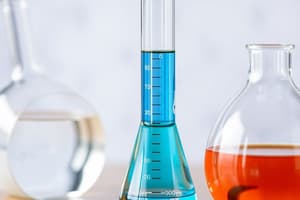Podcast
Questions and Answers
Qual é o reagente limitante em uma reação entre 3 moles de SO2 e 2 moles de O2 para formar SO3?
Qual é o reagente limitante em uma reação entre 3 moles de SO2 e 2 moles de O2 para formar SO3?
- SO2, pois requer 2 moles de O2 para cada 3 moles de SO2 (correct)
- Não há reagente limitante nessa reação
- SO3, pois é o produto final da reação
- O2, pois requer 3 moles de O2 para cada 2 moles de SO2
Como é calculado o rendimento percentual em uma reação química?
Como é calculado o rendimento percentual em uma reação química?
- Quantidade de produto obtido dividido pela quantidade de reagente inicial, expresso em porcentagem
- Massa do produto dividido pela massa do reagente limitante, expresso em porcentagem
- Rendimento teórico dividido pelo rendimento real, expresso em porcentagem
- Rendimento real dividido pelo rendimento teórico, expresso em porcentagem (correct)
O conceito de mol é fundamental na química e relaciona a massa de uma substância ao número de partículas que ela contém. Qual é o número de Avogadro?
O conceito de mol é fundamental na química e relaciona a massa de uma substância ao número de partículas que ela contém. Qual é o número de Avogadro?
- 6.022 x 10^23 (correct)
- 6.022 x 10^-22
- 6.022 x 10^-23
- 6.022 x 10^22
Como são feitos os cálculos estequiométricos em uma reação química?
Como são feitos os cálculos estequiométricos em uma reação química?
Qual é a massa molar de uma substância?
Qual é a massa molar de uma substância?
Qual é o objetivo principal da estequiometria em reações químicas?
Qual é o objetivo principal da estequiometria em reações químicas?
O que são os coeficientes estequiométricos em uma equação química balanceada?
O que são os coeficientes estequiométricos em uma equação química balanceada?
O que é um reagente limitante em uma reação química?
O que é um reagente limitante em uma reação química?
Como a estequiometria ajuda a determinar o rendimento percentual de uma reação química?
Como a estequiometria ajuda a determinar o rendimento percentual de uma reação química?
Qual é o papel do conceito de mol na estequiometria de uma reação química?
Qual é o papel do conceito de mol na estequiometria de uma reação química?
Flashcards are hidden until you start studying
Study Notes
Stoichiometry in General Chemistry at the Advanced Level: A Comprehensive Guide
Introduction to Stoichiometry
Stoichiometry is a crucial concept in chemistry, particularly at the advanced level. It is used to calculate the amounts of reactants and products involved in chemical reactions. Stoichiometry is based on the law of conservation of mass, which states that the total mass of the reactants equals the total mass of the products. This principle allows us to determine the amounts of substances needed for a balanced reaction and the amounts of products that can be produced.
Stoichiometry in Chemical Reactions
In a chemical reaction, stoichiometry helps us understand the relative proportions of reactants and products. This is achieved through stoichiometric coefficients, which indicate the ratio of moles of each reactant and product in a balanced chemical equation. For example, in the reaction of magnesium (Mg) and oxygen (O2) to form magnesium oxide (MgO), the stoichiometric coefficients are given by the balanced equation:
2 Mg(s) + O2(g) → 2 MgO(s)
Limiting Reactants
In a chemical reaction, one of the reactants is typically used up first, and this reactant is known as the limiting reactant. Once a reactant is used up, the reaction will stop, and any other reactants not yet reacted will remain unused. The limiting reactant determines the maximum amount of product that can be formed in a reaction. For example, if 3 moles of SO2 react with 2 moles of O2 to form SO3, the limiting reactant is SO2, as it requires 2 moles of O2 for every 3 moles of SO2.
Percent Yield
Stoichiometry is also used to calculate the theoretical yield of a chemical reaction, which is the amount of product that should theoretically be produced if all the reactants react completely. The actual yield is often lower, which can be attributed to various factors such as incomplete reactions, side reactions, and impurities. The percent yield is the actual yield divided by the theoretical yield, expressed as a percentage.
Stoichiometry Calculations
Stoichiometry calculations involve determining the number of moles of reactants and products in a chemical reaction. This is done by using the stoichiometric coefficients from a balanced chemical equation and the molar masses of the reactants and products. For example, if 12 g of magnesium is completely combusted in air, the mass of magnesium oxide formed can be calculated using the balanced equation:
2 Mg(s) + O2(g) → 2 MgO(s)
Mole Concept
The mole concept is a fundamental principle in chemistry that relates the mass of a substance to the number of particles it contains. One mole of a substance contains Avogadro's number of particles, which is approximately 6.022 × 10^23. The mass of one mole of a substance is its molar mass, which is the sum of the atomic masses of all the atoms in the substance.
In conclusion, stoichiometry is a crucial concept in advanced-level general chemistry. It helps us understand the relative proportions of reactants and products in chemical reactions, determine the maximum amount of product that can be formed, and calculate the actual yield of a reaction. By mastering stoichiometry, chemists can optimize reaction conditions, predict the amount of waste produced, and determine the amounts of reactants required to produce a specific amount of product.
Studying That Suits You
Use AI to generate personalized quizzes and flashcards to suit your learning preferences.




